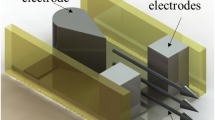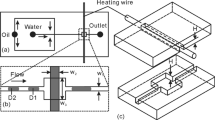Abstract
The droplet non-coalescence is an interesting phenomenon that is observed in nature. This phenomenon of non-coalescence is slightly counter-intuitive as we expect liquid interfaces of the same surface tension to merge when they come in contact. However, with the help of modulating oil film in between the liquid interface, non-coalescence is observed for long durations. In this work, we have achieved the non-coalescence of multiple compound droplets on a coplanar EWOD device. The effect of droplet volume on the non-coalescence phenomenon has been studied in two-droplet systems. We have obtained the non-coalescence regime map for different operating parameters of applied voltage and frequency. We have also explored three-droplet systems and obtained a non-coalescence regime. This open-chip coplanar EWOD device configuration can be used to scale up this phenomenon to multiple droplets.




Similar content being viewed by others
Data availability
Data are available from authors on request.
References
K. Choi, A.H.C. Ng, R. Fobel, A.R. Wheeler, Digital microfluidics. Annu. Rev. Anal. Chem. 5, 413–440 (2012). https://doi.org/10.1146/annurev-anchem-062011-143028
A. Renaudin, P. Tabourier, J.C. Camart, C. Druon, Surface acoustic wave two-dimensional transport and location of microdroplets using echo signal. J. Appl. Phys. 100, 1–4 (2006). https://doi.org/10.1063/1.2388725
Y. Zhang, N.T. Nguyen, Magnetic digital microfluidics - a review. Lab Chip 17, 994–1008 (2017). https://doi.org/10.1039/c7lc00025a
T.B. Jones, M. Gunji, M. Washizu, M.J. Feldman, Dielectrophoretic liquid actuation and nanodroplet formation. J. Appl. Phys. 89, 1441–1448 (2001). https://doi.org/10.1063/1.1332799
M. Dupeyrat, E. Nakache, Electrocapillarity and electroadsorption. J. Colloid Interface Sci. 73, 332–344 (1980). https://doi.org/10.1016/0021-9797(80)90080-6
F. Mugele, J.C. Baret, Electrowetting: from basics to applications. J. Phys. Condens. Matter (2005). https://doi.org/10.1088/0953-8984/17/28/R01
C. Quilliet, B. Berge, Electrowetting: a recent outbreak. Curr. Opin. Colloid Interface Sci. 6, 34–39 (2001). https://doi.org/10.1016/S1359-0294(00)00085-6
S. Bansal, P. Sen, Mixing enhancement by degenerate modes in electrically actuated sessile droplets. Sens. Actuators B Chem. 232, 318–326 (2016). https://doi.org/10.1016/J.SNB.2016.03.109
K.N. Nampoothiri, M.S. Seshasayee, V. Srinivasan, M.S. Bobji, P. Sen, Direct heating of aqueous droplets using high frequency voltage signals on an EWOD platform. Sens. Actuators B Chem. 273, 862–872 (2018). https://doi.org/10.1016/j.snb.2018.06.091
S. Bansal, P. Sen, Electrowetting based local sensing of liquid properties using relaxation dynamics of stretched liquid interface. J. Colloid Interface Sci. 568, 8–15 (2020). https://doi.org/10.1016/J.JCIS.2020.02.035
M.G. Pollack, A.D. Shenderov, R.B. Fair, Electrowetting-based actuation of droplets for integrated microfluidics. Lab Chip 2, 96–101 (2002). https://doi.org/10.1039/b110474h
U.C. Yi, C.J. Kim, Characterization of electrowetting actuation on addressable single-side coplanar electrodes. J. Micromech. Microeng. 16, 2053–2059 (2006). https://doi.org/10.1088/0960-1317/16/10/018
C.G. Cooney, C.Y. Chen, M.R. Emerling, A. Nadim, J.D. Sterling, Electrowetting droplet microfluidics on a single planar surface. Microfluid. Nanofluidics 2, 435–446 (2006). https://doi.org/10.1007/s10404-006-0085-8
S. Bansal, P. Sen, Axisymmetric and nonaxisymmetric oscillations of sessile compound droplets in an open digital microfluidic platform. Langmuir 33, 11047–11058 (2017). https://doi.org/10.1021/acs.langmuir.7b02042
J. Li, Y. Wang, H. Chen, J. Wan, Electrowetting-on-dielectrics for manipulation of oil drops and gas bubbles in aqueous-shell compound drops. Lab Chip 14, 4334–4337 (2014). https://doi.org/10.1039/C4LC00977K
L. Malic, D. Brassard, T. Veres, M. Tabrizian, Integration and detection of biochemical assays in digital microfluidic LOC devices. Lab Chip. 10, 418–431 (2010). https://doi.org/10.1039/B917668C
M.J. Lyell, T.G. Wang, Oscillations of a viscous compound drop. Phys. Fluids 29, 3481 (1998). https://doi.org/10.1063/1.865817
Y. Zhu, Y.X. Zhang, L.F. Cai, Q. Fang, Sequential operation droplet array: an automated microfluidic platform for picoliter-scale liquid handling, analysis, and screening. Anal. Chem. 85, 6723–6731 (2013). https://doi.org/10.1021/AC4006414/SUPPL_FILE/AC4006414_SI_004.AVI
R.A. Hayes, B.J. Feenstra, Video-speed electronic paper based on electrowetting. Nature 2003(425), 383–385 (2003). https://doi.org/10.1038/nature01988
M. Chakraborty, A. Ghosh, S. DasGupta, Enhanced microcooling by electrically induced droplet oscillation. RSC Adv. 4, 1074–1082 (2013). https://doi.org/10.1039/C3RA46401F
M.R. Foreman, S. Avino, R. Zullo, H.-P. Loock, F. Vollmer, G. Gagliardi, Enhanced nanoparticle detection with liquid droplet resonators. Eur. Phys. J. Spec. Top. 2014(223), 1971–1988 (2014). https://doi.org/10.1140/EPJST/E2014-02240-9
M. Chabert, K.D. Dorfman, J.L. Viovy, Droplet fusion by alternating current (AC) field electrocoalescence in microchannels. Electrophoresis 26, 3706–3715 (2005). https://doi.org/10.1002/ELPS.200500109
R.S. Allan, S.G. Mason, Particle motions in sheared suspensions. XIV. Coalescence of liquid drops in electric and shear fields. J. Colloid Sci. 17, 383–408 (1962). https://doi.org/10.1016/0095-8522(62)90016-8
K. Ahn, C. Kerbage, T.P. Hunt, R.M. Westervelt, D.R. Link, D.A. Weitz, Dielectrophoretic manipulation of drops for high-speed microfluidic sorting devices. Appl. Phys. Lett. 88, 1–3 (2006). https://doi.org/10.1063/1.2164911
T. Liu, S. Seiffert, J. Thiele, A.R. Abate, D.A. Weitz, W. Richtering, Non-coalescence of oppositely charged droplets in pH-sensitive emulsions. Proc. Natl. Acad. Sci. 109, 384–389 (2012). https://doi.org/10.1073/PNAS.1019196109
Y. Couder, E. Fort, C.-H. Gautier, A. Boudaoud, From bouncing to floating: noncoalescence of drops on a fluid bath. Phys. Rev. Lett. 94, 177801 (2005). https://doi.org/10.1103/PhysRevLett.94.177801
S. Karpitschka, H. Riegler, Sharp transition between coalescence and non-coalescence of sessile drops. J. Fluid Mech. 743, 1 (2014). https://doi.org/10.1017/JFM.2014.73
F. Pacheco-Vázquez, R. Ledesma-Alonso, J.L. Palacio-Rangel, F. Moreau, Triple Leidenfrost effect: preventing coalescence of drops on a hot plate. Phys. Rev. Lett. 127, 204501 (2021). https://doi.org/10.1103/PHYSREVLETT.127.204501/FIGURES/5/MEDIUM
S. Bansal, P. Sen, Effect of electrowetting induced capillary oscillations on coalescence of compound droplets. J. Colloid Interface Sci. 530, 223–232 (2018)
Acknowledgements
The authors would like to acknowledge the National Nanofabrication Centre and the Micro/Nano Characterization Facility at CeNSE, IISc for the fabrication and characterization. All the authors would like to thank the Department of Science and Technology and Ministry of Education, Government of India for financial support. Rutvik Lathia wants to acknowledge Prime Minister's Research Fellowship for the financial support.
Author information
Authors and Affiliations
Corresponding author
Supplementary Information
Below is the link to the electronic supplementary material.
Rights and permissions
Springer Nature or its licensor holds exclusive rights to this article under a publishing agreement with the author(s) or other rightsholder(s); author self-archiving of the accepted manuscript version of this article is solely governed by the terms of such publishing agreement and applicable law.
About this article
Cite this article
Lathia, R., Sagar, N. & Sen, P. Multi-droplets non-coalescence on open-chip electrowetting platform. Eur. Phys. J. Spec. Top. 232, 859–865 (2023). https://doi.org/10.1140/epjs/s11734-022-00661-z
Received:
Accepted:
Published:
Issue Date:
DOI: https://doi.org/10.1140/epjs/s11734-022-00661-z




